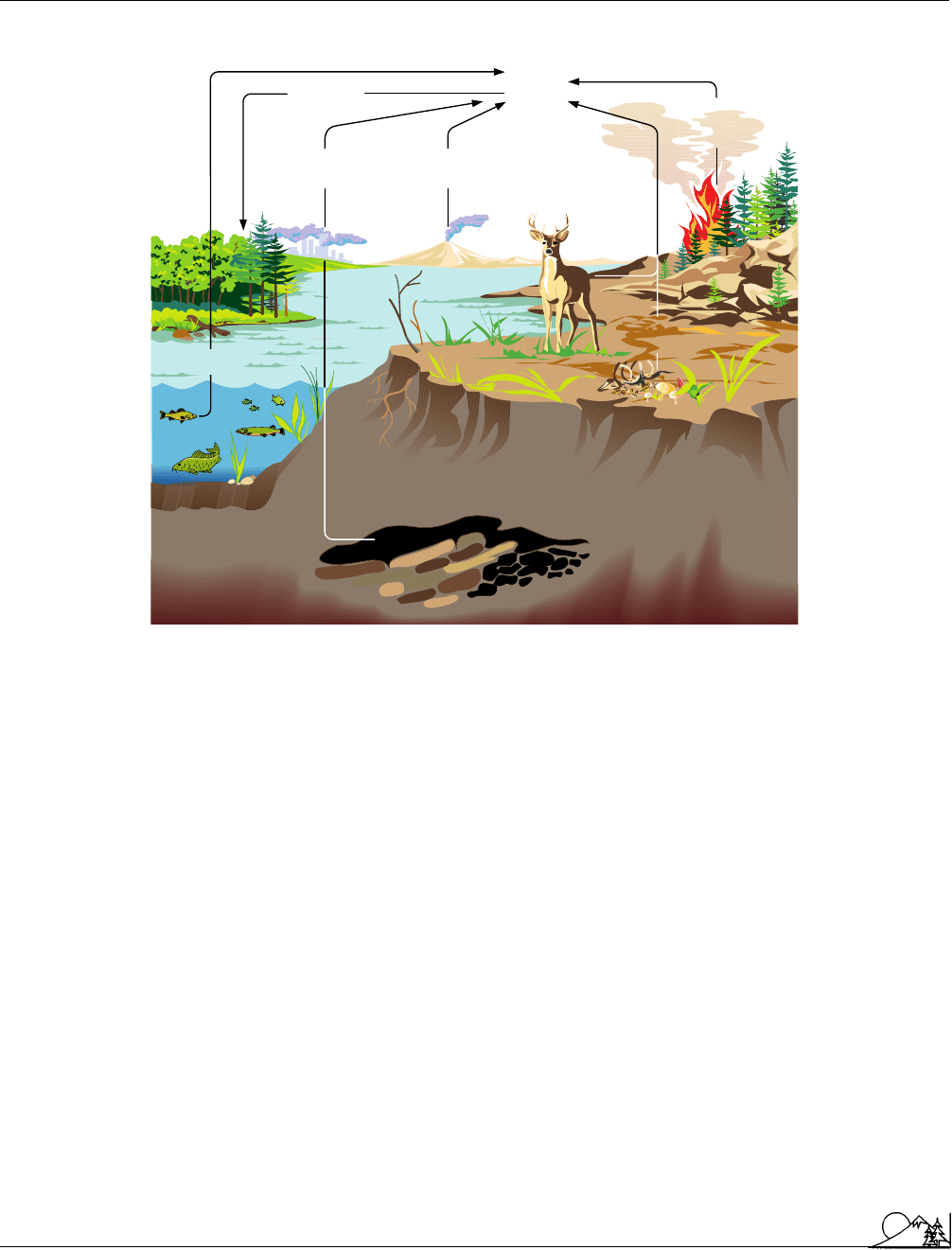Environmental Encyclopedia
Подождите немного. Документ загружается.


Environmental Encyclopedia 3
Cancer
tional Trade in
Endangered Species
of Fauna and Flora
(CITES), and the Ramsar
Convention on Wetlands of
International Importance
. Furthermore, it has increased
responsibility on federal lands, north of 60°N latitude, al-
though in recent years much responsibility has been dele-
gated to the territorial wildlife services and local co-manage-
ment agreements with aboriginal peoples.
Within those statutes and agreements CWS is respon-
sible for policy and strategy development, enforcement, re-
search, public relations, education and interpretation,
habi-
tat
classification, and the management of about 98
sanctuaries and 49 wildlife areas. The combination of a
national and international mandates and diverse landscapes
of Canada make CWS the pivotal
wildlife management
institution in Canada. However, CWS’s increasing reliance
on cooperative measures with provincial governments and
nongovernmental organizations, including
Ducks Unlimited
Canada and
World Wildlife Fund
Canada, has led the orga-
nization to less direct management and more coordination
activities. Critics of Canada’s wildlife management direction
have suggested that the once world-renowned repository of
research expertise in CWS has suffered in recent years.
[David A. Duffus]
R
ESOURCES
O
RGANIZATIONS
Canadian Wildlife Service, Environment Canada, Ottawa, Ontario Canada
K1A 0H3 (819) 997-1095, Fax: (819) 997-2756 , Email: cws-scf@ec.gc.ca,
<http://www.cws-scf.ec.gc.ca>
Cancer
A malignant tumor, cancer comprises a broad spectrum of
malignant neoplasms classified as either carcinomas or sarco-
mas. Carcinomas originate in the epithelial tissues, while sar-
comas originate from connective tissues and structures that
have their origin in mesodermal tissue. Cancer is an invasive
disease that spreads to various parts of the body. It spreads
directly to those tissues immediately surrounding the primary
site of the cancer and may spread to remote parts of the body
through the lymphatic and circulatory systems.
Cancer occurs in most, if not all, multicellular animals.
Evidence from fossil records reveal bone cancer in dinosaurs,
and sarcomas have been found in the bones of Egyptian
mummies. Hippocrates is credited with coining the term
carcinoma, the Greek word for crab. Why the word for crab
was chosen enjoys much speculation, but may have had to
do with the sharp, biting pain and invasive, spreading nature
of the disease.
A
carcinogen
is any substance or agent that produces
or induces the development of cancer. Carcinogens are
207
known to affect and initiate metabolic processes at the level
of DNA (the information-storing molecules in cells). DNA
damage (
mutation
) is the development of cancer after expo-
sure to a carcinogen. This kind of mutation is actually revers-
ible; our bodies continually experience DNA damage, which
is continually being corrected. It is only when promoter
cells intervene during cell proliferation that tumors begin to
develop. Although several agents can induce cell division,
only promoters induce tumor development.
An example of this process would be what happens
in an epidermal cell, when its DNA undergoes rapid, irre-
versible alteration or mutation after exposure to a carcinogen.
The cell undergoes proliferation, producing altered progeny,
and it is at this point that the cell may proceed on one of
two pathways. The cell may undergo interrupted exposure
to promoters and experience early reversible precancerous
lesions. Or it may experience continuous exposure to the
promoters, thereby causing malignant cell changes. During
the late phase of promotion, the primary epidermal cell
becomes tumorous and begins to invade normal cells; then
it begins to spread. It is at this stage that tumors are identified
as malignant.
The spread of tumors throughout the body is believed
to be governed by several processes. One possible mechanism
is direct invasion of contiguous organs. This mechanism is
poorly understood, but it involves multiplication, mechanical
pressure, release of lytic enzymes, and increased motility of
individual tumor cells. A second process is metastasis. This
is the spread of cancer cells from a primary site of origin to
a distant site, and it is the life-threatening aspect of malig-
nancy. At present there are many procedures available to
surgeons for successfully eradicating primary tumors; how-
ever, the real challenge in reducing cancer
mortality
is find-
ing ways to control metastasis.
Clinical manifestations of cancer take on many forms.
Usually little or no pain is associated with the early stages
of malignant disease, but pain does affect 60–80% of those
terminally ill with cancer. General mechanisms causing pain
associated with cancer include pressure, obstruction, invasion
of a sensitive structure, stretching of visceral surfaces, tissue
destruction, and inflammation. Abdominal pain is often
caused by severe stretching from the tumor invasion of the
hollow viscus, as well as tumors that obstruct and distend
the bowel. Tumor compression of nerve endings against a
firm surface also creates pain. Brain tumors have very little
space to grow without compressing blood vessels and nerve
endings between the tumor and the skull. Tissue destruction
from infection and necrosis can also cause pain. Frequently
infection occurs in the oral area, in which a common cause
of pain is ulcerative lesions of the mouth and esophagus.
Cancer treatments involve chemotherapy, radiother-
apy, surgery, immunotherapy, and combinations of these

Environmental Encyclopedia 3
Captive propagation and reintroduction
Frequency of Cancer-Related Death
Number of Deaths
Cancer Site Per Year
Lung 160,100
Colon and rectum 56,500
Breast 43,900
Prostate 39,200
Pancreas 28,900
Lymphoma 26,300
Leukemia 21,600
Brain 17,400
Stomach 13,700
Liver 13,000
Esophagus 11,900
Bladder 12,500
Kidney 11,600
Multiple myeloma 11,300
modalities. Chemotherapy and its efficacy is related to how
the drug enters the cell cycle; the design of the therapy is
to destroy enough malignant cells so that the body’s own
immune system can destroy the remaining cells naturally.
Smaller tumors with rapid growth rates seem to be most
responsive to chemotherapy. Radiation therapy is commonly
used to eradicate tumors without excessive damage to sur-
rounding tissues. Radiation therapy attacks the malignant
cell at the DNA level, disrupting its ability to reproduce.
Surgery is the treatment of choice when it has been deter-
mined that the tumor is intact and has not metastasized
beyond the limits of surgical excision. Surgery is also indi-
cated for benign tumors that could progress into malignant
tumors. Premalignant and in situ tumors of epithelial tissues,
such as skin, mouth, and cervix, can be removed.
Chemotherapy and radiation treatments are the most
commonly used therapies for cancer. Unfortunately, both
methods produce unpleasant side effects; they often suppress
the immune system, making it difficult for the body to
destroy the remaining cancer even after the treatment has
been successful. In this regard, immunotherapy holds great
promise as an alternative treatment, because it makes use of
the unique properties of the immune system.
Immunotherapies for the treatment of cancer are gen-
erally referred to as biological response modifiers (BRMs).
BRMs are defined as mammalian gene products, agents,
and clinical protocols that affect biologic responses in host-
tumor interactions. Immunotherapies have a direct cytotoxic
effect on cancer cells, initiation or augmentation of the host’s
208
tumor-immune rejection response, and modification of can-
cer cell susceptibility to the lytic or tumor static effects of
the immune system. As with other cancer therapies immuno-
therapies are not without their own side effects. Most com-
mon are flu-like symptoms, skin rashes, and vascular-leak
syndrome. At their worst, these symptoms are usually less
severe than those of current chemotherapy and radiation
treatments. See also Hazardous material; Hazardous waste;
Leukemia; Radiation sickness
[Brian R. Barthel]
R
ESOURCES
B
OOKS
Aldrich, T., and J. Griffith. Environmental Epidemiology. New York: Van
Nostrad Reinhold, 1993.
Captive propagation and
reintroduction
Captive propagation is the deliberate breeding of wild ani-
mals in captivity in order to increase their numbers. Reintro-
duction is the deliberate release of these
species
into their
native
habitat
. The Mongolian wild horse, Pere David’s
deer, and the American
bison
would probably have become
extinct without captive propagation. Nearly all cases of cap-
tive propagation and reintroduction involve threatened or
endangered species
. Zoos are increasingly involved in cap-
tive propagation, sometimes using new technologies. One
of these, allows a relatively common species of antelope to
act as a surrogate mother and give birth to a
rare species
.
Once suitable sites are selected, a reintroduction can
take one of three forms. Reestablishment reintroductions take
place in areas where the species once occurred but is now
entirely absent. Recent examples include the red wolf, the
black-footed ferret
, and the
peregrine falcon
east of the
Mississippi River. Biologists use augmentation reintroduction
to release captive-born wild animals into areas in which the
species still occurs but only in low numbers. These new
animals can help increase the size of the population and
enhance genetic diversity. Examples include a small Brazilian
monkey called the golden lion tamarin and the peregrine
falcon in the western United States. A third type, experimen-
tal reintroduction, acts as a test case to acquire essential infor-
mation for use on larger-scale permanent reintroductions.
The red wolf was first released as an experimental reintroduc-
tion. A 1982 amendment to the
Endangered Species Act
facilitates experimental reintroductions, offering specific ex-
emptions from the Act’s protection, allowing managers
greater flexibility should reintroduced animals cause unex-
pected problems.

Environmental Encyclopedia 3
Captive propagation and reintroduction
The release of baby Kemp’s ridley sea turtles on a beach in Mexico. (Photograph by C. Allan Morgan. Peter Arnold Inc.
Reproduced by permission.)
Yet captive propagation and reintroduction programs
have their drawbacks, the chief one being their high cost.
Capture from the wild, food, veterinary care, facility use and
maintenance all contribute significant costs to maintaining
an animal in captivity. Other costs are incurred locating
suitable reintroduction sites, preparing animals for release,
and monitoring the results. Some conservationists have ar-
gued that the money would be better spent acquiring and
protecting habitat in which remnant populations already live.
There are also other risks associated with captive pro-
pogation programs such as disease, but perhaps the greatest
biological concern is that captive populations of endangered
species might lose learned or genetic traits essential to their
survival in the wild. Animals fed from birth, for example,
might never pick up food-gathering or prey-hunting skills
from their parents as they would in the wild. Consequently,
when reintroduced such animals may lack the skill to feed
themselves effectively. Furthermore, captive breeding of ani-
mals over a number of generations could affect their
evolu-
tion
. Animals that thrive in captivity might have a selective
advantage over their “wilder” cohorts in a
zoo
, but might
209
be disadvantaged upon reintroduction by the very traits that
aided them while in captivity.
Despite these shortcomings, the use of captive propa-
gation and reintroduction will continue to increase in the
decades to come. Biologists learned a painful lesson about
the fragility of endangered species in 1986 when a sudden
outbreak of canine distemper decimated the only known
group of black-footed ferrets. The last few ferrets were taken
into captivity where they successfully bred. Even as new
ferret populations become established through reintroduc-
tion, some ferrets will remain as captive breeders for insur-
ance against future catastrophes. Biologists are also steadily
improving their methods for successful reintroduction. They
have learned how to select the combinations of sexes and
ages that offer the best chance of success and have developed
systematic ways to choose the best reintroduction sites.
Captive propagation and reintroduction will never be-
come the principal means of restoring threatened and endan-
gered species, but it has been proven effective and will con-
tinue to act as insurance against sudden or catastrophic losses

Environmental Encyclopedia 3
Carbon
in the wild. See also Biodiversity; Extinction; Wildlife man-
agement; Wildlife rehabilitation
[James H. Shaw]
R
ESOURCES
P
ERIODICALS
Jones, Suzanne R., ed. “Captive Propagation and Reintroduction: A Strategy
for Preserving Endangered Species?” Endangered Species Update 8 (1) (1990):
1-88.
Lindburg, Donald G. “Are Wildlife Reintroductions Worth the Cost?”
Zoo Biology 11 (1992): 1-2.
Carbamates
see
Pesticide
Carbon
The seventeenth most abundant element on earth, carbon
occurs in at least six different allotropic forms, the best
known of which are diamond and graphite. It is a major
component of all biochemical compounds that occur in living
organisms: carbohydrates, proteins, lipids, and nucleic acids.
Carbon-rich rocks and minerals such as limestone, gypsum,
and marble often are created by accumulated bodies of
aquatic organisms. Plants, animals, and
microorganisms
cycle carbon through the
environment
, converting it from
simple compounds like
carbon dioxide
and
methane
to
more complex compounds like sugars and starches, and then,
by the action of
decomposers
, back again to simpler com-
pounds. One of the most important
fossil fuels
,
coal
,is
composed chiefly of carbon.
Carbon cycle
Carbon
makes up no more than 0.27% of the mass of all
elements in the universe and only 0.0018% by weight of the
elements in the earth’s crust. Yet, its importance to living
organisms is far out of proportion to these figures. In contrast
to its relative
scarcity
in the
environment
, it makes up
19.4% by weight of the human body. Along with
hydrogen
,
carbon is the only element to appear in every organic mole-
cule in every living organism on earth.
The series of chemical, physical, geological, and bio-
logical changes by which carbon moves through the earth’s
air, land, water, and living organisms is called the carbon
cycle.
In the
atmosphere
, carbon exists almost entirely as
gaseous
carbon dioxide
. The best estimates are that the
earth’s atmosphere contains 740 billion tons of this gas. Its
210
global concentration is about 350
parts per million
(ppm),
or 0.035% by volume. That makes carbon dioxide the fourth
most abundant gas in the atmosphere after
nitrogen
, oxygen
and argon. Some carbon is also released as
carbon monox-
ide
to the atmosphere by natural and human mechanisms.
This gas reacts readily with oxygen in the atmosphere, how-
ever, converting it to carbon dioxide.
Carbon returns to the hydrosphere when carbon diox-
ide dissolves in the oceans, as well as in lakes and other
bodies of water. The solubility of carbon dioxide in water
is not especially high, 88 milliliters of gas in 100 milliliters
of water. Still, the earth’s oceans are such a vast
reservoir
that experts estimate that approximately 36,000 billion tons
of carbon are stored there. They also estimate that about 93
billion tons of carbon flows from the atmosphere into the
hydrosphere each year.
Carbon moves out of the oceans in two ways. Some
escapes as carbon dioxide from water solutions and returns
to the atmosphere. That amount is estimated to be very
nearly equal (90 billion tons) to the amount entering the
oceans each year. A smaller quantity of carbon dioxide (about
40 billion tons) is incorporated into aquatic plants.
On land, green plants remove carbon dioxide from the
air through the process of photosynthesis—a complex series
of chemical reactions in which carbon dioxide is eventually
converted to starch, cellulose, and other carbohydrates.
About 100 billion tons of carbon are transferred to green
plants each year, and a total of 560 billion tons of the element
is thought to be stored in land plants alone.
The carbon in green plants is eventually converted into
a large variety of organic (carbon-containing) compounds.
When green plants are eaten by animals, carbohydrates and
other organic compounds are used as raw materials for the
manufacture of thousands of new organic substances. The
total collection of complex organic compounds stored in all
kinds of living organisms represents the reservoir of carbon
in the earth’s
biosphere
.
The cycling of carbon through the biosphere involves
three major kinds of organisms. Producers are organisms
with the ability to manufacture organic compounds such as
sugars and starches from inorganic raw materials such as
carbon dioxide and water. Green plants are the primary
example of producing organisms. Consumers are organisms
that obtain their carbon (that is, their food) from producers:
all animals are consumers. Finally,
decomposers
are organ-
isms such as bacteria and
fungi
that feed on the remains of
dead plants and animals. They convert carbon compounds
in these organisms to carbon dioxide and other products.
The carbon dioxide is then returned to the atmosphere to
continue its path through the carbon cycle.
Land plants return carbon dioxide to the atmosphere
during the process of
respiration
. In addition, animals that

Environmental Encyclopedia 3
Carbon emissions trading
eat green plants exhale carbon dioxide, contributing to the
50 billion tons of carbon released to the atmosphere by
all forms of living organisms each year. Respiration and
decomposition
both represent, in the most general sense,
a reverse of the process of
photosynthesis
. Complex organic
compounds are oxidized with the release of carbon dioxide
and water—the raw materials from which they were origi-
nally produced.
At some point, land and aquatic plants and animals
die and decompose. When they do so, some carbon (about
50 billion tons) returns to the atmosphere as carbon dioxide.
The rest remains buried in the earth (up to 1,500 billion
tons) or on the ocean bottoms (about 3,000 billion tons).
Several hundred million years ago, conditions of burial were
such that organisms decayed to form products consisting
almost entirely of carbon and
hydrocarbons
. Those materi-
als exist today as pockets of the fossil fuels—coal, oil, and
natural gas
. Estimates of the carbon stored in
fossil fuels
range from 5,000 to 10,000 billion tons.
The processes that make up the carbon cycle have
been occurring for millions of years, and for most of this
time, the systems involved have been in equilibrium. The
total amount of carbon dioxide entering the atmosphere
from all sources has been approximately equal to the total
amount dissolved in the oceans and removed by photosyn-
thesis. However, a hundred years ago changes in human
society began to unbalance the carbon cycle. The Industrial
Revolution initiated an era in which the burning of fossil
fuels became widespread. In a short amount of time, large
amounts of carbon previously stored in the earth as
coal
,
oil, and natural gas were burned up, releasing vast quantities
of carbon dioxide into the atmosphere.
Between 1900 and 1992, measured concentrations of
carbon dioxide in the atmosphere increased from about 296
ppm to over 350 ppm. Scientists estimate that fossil fuel
combustion
now released about five billion tons of carbon
dioxide into the atmosphere each year. In an equilibrium
situation, that additional five billion tons would be absorbed
by the oceans or used by green plants in photosynthesis. Yet
this appears not to be happening: measurements indicate
that about 60% of the carbon dioxide generated by fossil
fuel combustion remains in the atmosphere.
The problem is made even more complex because of
deforestation
. As large tracts of forest are cut down and
burned, two effects result: carbon dioxide from forest fires
is added to that from other sources, and the loss of trees
decreases the worldwide rate of photosynthesis. Overall, it
appears that these two factors have resulted in an additional
one to two billion tons of carbon dioxide in the atmosphere
each year.
No one can be certain about the environmental effects
of this disruption of equilibria in the carbon cycle. Some
211
authorities believe that the additional carbon dioxide will
augment the earth’s natural
greenhouse effect
, resulting
in long-term global warming and
climate
change. Other
argue that we still do not know enough about the way
oceans, clouds, and other factors affect climate to allow such
predictions.
This controversy involves a difficult choice. Should
actions that could potentially cost billions of dollars be taken
to reduce the
emission
of carbon dioxide when evidence
for climate change is still uncertain? Or should governments
wait until that evidence becomes more clear, with the risk
that needed actions may then come too late.
[David E. Newton]
R
ESOURCES
B
OOKS
McGraw-Hill Encyclopedia of Science & Technology. 7th ed. New York:
McGraw-Hill, 1992.
Carbon dating
see
Radiocarbon dating
Carbon dioxide
The fourth most abundant gas in the earth’s
atmosphere
,
carbon
dioxide occurs in an abundance of about 350
parts
per million
. The gas is released by volcanoes and during
respiration
,
combustion
, and decay. Plants convert carbon
dioxide into carbohydrates by the process of
photosynthe-
sis
. Carbon dioxide normally poses no health hazard to
humans. An important factor in maintaining the earth’s
climate
, molecules of carbon dioxide capture heat radiated
from the earth’s surface, raising the planet’s temperature to
a level at which life can be sustained, a phenomenon known
as the
greenhouse effect
. Some scientists believe that in-
creasing levels of carbon dioxide resulting from human activi-
ties are now contributing to a potentially dangerous global
warming.
Carbon emissions trading
Carbon
emissions trading (CET) is a practice allowing coun-
tries—and corporations—to trade their harmful carbon emis-
sions for credit to meet their designated carbon
emission
lim-
its. Most developed countries approved this system in 1992
whenthe United Nations FrameworkConvention on Climate
Change (UNFCCC) was presented. The document provided
for limits on greenhouse gas emissions in an attempt to stem
the determination of climate change around the world. The

Environmental Encyclopedia 3
Carbon emissions trading
Carbon
dioxide in
atmosphere
Photosynthesis
Fires from use of
fuel wood and
conversion of
forest to agriculture
Aerobic respiration and
decay (plants, animals,
and decomposers)
Carbon
released from
volcanoes
Combustion, and
the manufacturing
of cement
Fossil fuels
Aerobic respiration
and decay
Stored in sediments
Carbon cycle. (Illustration by Hans & Cassidy.)
United States as of 2001 had backed away from the Kyoto
Treaty stating similar restriction but would remain obligated
in some regard to the UNFCCC. At least in theory, CET
allows one country who might not be maintaining their target
to trade credits with others that are well under theirs.
According to information from the Australian Acad-
emy of Science, in Nova: Science in the news,
carbon dioxide
(CO2) is known as a “greenhouse gas” ones that came out
of the Earth’s crust before life was known to begin, helping
to stabilize the earth’s temperatures in order to sustain life.
The “greenhouse effect” occurs when the sun’s heat energy
passes through the
atmosphere
and warms up the earth
with no interference. The Earth then radiates that same
energy back into space. Other
greenhouse gases
include,
water vapor (the primary greenhouse gas),
methane
,
ozone
,
carbon monoxide
, and
nitrous oxide
. All of these absorb
part of this energy and send it in all directions—including the
Earth. By the twenty-first century however, the emissions of
greenhouse gases were not in the balance they had been for
ages due to human activity, particularly that of burning
fossil
fuels
such as
coal
, oil, and
natural gas
. Due to that, and
to industrial development as well as residential development
212
in the developed countries, forests were cleared at such a
rate that inclined some scientists to wonder whether these
practices were harmful in the significantly increased emis-
sions of greenhouse gases.
The
Environmental Protection Agency
(EPA)
launched a method of emissions trading known as, Online
Allowance Transfer System (OATS). It is an online system
that allows companies engaged in the
sulfur dioxide
and
nitrogen
oxide to record trades directly through the internet
without having to file papers with the EPA. No such method
yet exists for CET. In view of possible future issues regarding
the trades in the United States in February 2002, Senators
John McCain (R.-Ariz) and Sam Brownback(R.-Kan.)
jointly introduced legislation that propsed establishing a na-
tional voluntary registry for companies to register carbon
emission reductions. According to Coal Age “The propsal is
a step toward developing a ’cap-and-trade’ carbon emissions
control program.” Senators McCain and Leiberman (D.-
CT) are also working on legislation that supports carbon
emissions trading. McCain, noted Coal Age said that, “The
registry would support current voluntary trading practices in
private industry and other nongovernmental organizations.”

Environmental Encyclopedia 3
Carbon emissions trading
The real issue that has resulted from CET is the
trading market that has emerged. Opinions are varied re-
garding the advisability, and inherent dangers of CET. The
International Carbon Bank & Exchange offered insight on
CET through its web site. “Emissions trading reduces costs
by allowing a field of players to achieve emissions redutions
using market mechanisms. Over time, these mechanisms
will drive emissions down and finance the shift to clean
energy.”
In August 2001, the Joyce Foundation granted
$760,100 to fund the design phase of the Chicago Climate
Exchange (CCX). The grant was actually directed to the J. L.
Kellogg Graduate School of Management at Northwestern
University in support of the work being done by Dr. Richard
Sandor, an internationally-known trader. With the presiden-
tial administration of George W. Bush hesitant to apply a
“cap-and-trade” system, the direction of the CCX and open
market trading is viewed as providing a desirable alterna-
tive—particularly in light of the United States withdrawal
from the Kyoto Treaty. According the Environmental News
Network (ENN) in an article on the new design program,
“The CCX’s stated goal is to reduce participants’ greenhouse
gas emissions by five percent below 1999 levels over five
years. By comparison, the countries that ratified the Kyoto
Protocol must reduce emissions of carbon dioxide to an
average of 5.2% below 1990 levels during the five-year period
2008 to 2012.” By November 2001, the cities of Chicago
and Mexico City announced their participation in CET by
joining the CCX, with Chicago becoming the first American
city to do so. Chicago’s Mayor Richard Daley became honor-
ary chair of the exchange, still in the design phase. He noted
that, “For years our financial exchanges have been a vital
parto f the local and naitonal economy. This is a good
example of the kind of innovation that will help us solve
our energy and environmental problems,” according to the
Environment News Service. Other businesses and agencies
participating in the design phase of the CCX including,
Agrilance, a partnership of agricultural producer-owners,
local cooperatives and regional cooperatives; BP; Cinergy;
Ducks Unlimited
; DuPont; the energy company, Exeton;
International Paper; the Iowa Farm Bureau Federation;
Manitoba (CA) Hydro; National Council of Farmer Coop-
eratives; PG&E National Energy Group; Suncor Energy;
Swiss Re, a reinsurance firm;
The Nature Conservancy
;
and, Waste Energy.
On a broader scope of international trading, however,
the United States’ withdrawal from Kyoto was posing a
possible problem. Due to the lack of participation, U.S.
companies were seeing a possible short-term advantage in
international business competition due to lower costs with-
out the emissions trading—but those same companies, such
as DuPont, already cutting emissions, might face the long-
213
term shortchange depending on which way the international
climate change policy could effect trading those emissions.
In March 2002, Julie Vorman writing on the CET market
for Reuters quoted Eileen Claussen, president of the Pew
Center on Global Climate Change, noting that, “Despite
the United States inaction, it is abundantly clear that we are
beginning to see the outlines of a genuine greenhouse gas
market.” Also, according to Vorman, “The Pew Center re-
port said more than 65 trades of greenhouse gas emissions
totaling 55 million to 77 million tons have occurred over
the past five years [since the 1997 Kyoto Protocol was intro-
duced] but that those gifures probably underestimate the
market activity. The emissions reductions traded for between
60 cents and $3.50 (U.S. dollars) per ton of carbon dioxide
equivalent. (The date did not include trades within BP Pic
and Royal Dutch Shell, which launched their own internal
cap-and-trade programs in 1998 to cut emissions.)
The role of the agricultural industry in CET was being
explored along with its options with the CCX. According
to the American Farm Bureau, one of the plans under consid-
eration was a plan to pay farmers for agricultural practices
reducing carbon emissions into the atmosphere. “Farmers
would be compensated for implementing or continuing prac-
tices that reduce carbon emissions from the soils. Such prac-
tices include reducing tillage, conserving tillage, retiring
cropland, fertilizing with livestock manure, decreasing meth-
ane and reducing energy use. The compensation could po-
tentially come from the government or companies that are
interested in “trading” carbon credits.” The Kyoto Protocol
does not provide that option; but the Untied States wanted
to consider it as a part of the UNFCCC. Jon Doggett, a
senior director of governmental relations for the American
Farm Bureau Federation (AFBF) added the caveat that such
a practice of carbon sequestration in the soil—a practice
some Americans support in opposition to European leaders
who do not have the amount of land for such a program to
succeed as does the United States—could be harmful to
farmers in the long-term. Doggett noted that, “The indus-
tries that will be required to purchase the carbon credits
supply farmers with vital operating materials, including fuel
and
fertilizer
. As regulatory costs for companies rise, farmers
will pay for that as fuel and fertilizer costs go up. The
AFBF also pointed out that such storage might disrupt other
environmetally beneficial practices—such as that employed
by California producers after harvest when they flood their
land and provide a
habitat
for geese and ducks. The issues
of trading the benefits of one environmental concern for
that of another would remain a matter of debate well into
the century, no doubt.
Environmentalists continued to express concern that
CET practices, particularly ones that were regulated volunta-
rily on the open market, would not reduce the greenhouse

Environmental Encyclopedia 3
Carbon monoxide
gases to the extent that some scientists thought crucial to
the planet’s optimum survival. The ongoing debate on the
theory of global warming raged on in the United States
particularly. Business and industrial interests questioned the
soundness of the theory, and worried that it would create
serious obstacles to profits that might be translated into
the research necessary for better energy alternatives. Those
supporting the theory were concerned with declining stan-
dards for
pollution
controls that might enhance the
green-
house effect
. The voluntary controls industry and countries
would place on themselves were nonetheless considered the
first step to creating a cleaner
environment
.
[Jane E. Spear]
R
ESOURCES
B
OOKS
International Carbon Bank & Exchange. About Emissions Trading. “Emis-
sion Reduction Credits & Trading.” (June 2002). <http://www.icbe.com/>.
O
THER
Australian Academy of Science. Nova: Science in the News. “Carbon cur-
rency—the credits and debits of carbon emissions trading.” (June 2002).
<http://www.science.org.au/>
Chicago Climatex. Emissions Trading. (June 2002). <http://www.chica-
goclimatex.com/>
Coal Age. Primedia Business Magazines. “McCain, Brownback Move on
Emissions.” Feb. 1, 2002. <http://www.industrycli.../>
DMOZ. Open Directory.“Emissions Trading.” April 16, 2002. <http://
www.dmoz.org/Science/Environment/>
Earth Council. Carbon Trading: A Market Approach to the Environmental
Crisis. July 1997; (June 2002). <http://www.igc.apc.org/globalpolicy/>
Environmental News Network. Trading for clean air just got easier. December
5, 2001. <http://www.enn.com/>
Environmental News Network. First U.S. Carbon Trading Market Enters
Design Phase. August 8, 2001. <http://www.enn.com/>
Environment News Service. Environment. “Carbon Trading Market Ex-
pands to Chicago, Mexico City.” November 13, 2001. <http://www.ens.
lycos.com/ens/>
Eye for Energy. CO2 Trading: The North American Market. “Opportunities,
compliance and profit in domestic and international greenhouse gas emis-
sions trading.” June 2002. <http://www.eyeforenergy.com/>
Farm Bureau. Global Climate Change. “Agriculture’s role discussed in carbon
trading.” June 22, 2000; (June 2002). <http://www.fb.com/>
Houlder, Vanessa. FT (Financial Times). “US opposition to Kyota may
sink carbon trading.” August 13, 2001. <http://news.ft.com/>
Vorman, Julie. Reuters. “Greenhouse trading takes off, U.S. on sidelines.”
March 20, 2002). <http://www.enn.com/news/wire-stories/>
O
RGANIZATIONS
U. S. Environmental Protection Agency, 1200 Pennsylvania Avenue, N.W.,
Washington, D.C. United States 20460 (202)260-2090, www.epa.gov
Carbon monoxide
A colorless, odorless, tasteless gas that is produced in only
very small amounts by natural processes. By far the most
214
important source of the gas is the incomplete
combustion
of
coal
, oil, and
natural gas
. In terms of volume,
carbon
monoxide is the most important single component of
air
pollution
. Environmental scientists rank it behind sulfur
oxides,
particulate
matter,
nitrogen oxides
, and volatile
organic compounds, however, in terms of its relative hazard
to human health. In low doses, carbon monoxide causes
headaches, nausea, fatigue, and impairment of judgment. In
larger amounts, it causes unconsciousness and death.
Carbon offsets (CO
2
-emission offsets)
Many human activities result in large emissions of
carbon
dioxide
(CO
2
) and other so-called
greenhouse gases
into
the
atmosphere
. Especially important in this regard are the
use of
fossil fuels
such as
coal
, oil, and
natural gas
to
generate electricity, to heat spaces, and as a fuel for vehicles.
In addition, the disturbance of forests results in large emis-
sions of CO
2
into the atmosphere. This can be caused by
the conversion of forests into agricultural or urbanized land
uses, and also by the harvesting of timber.
During the past several centuries, human activities
have resulted in large emissions of CO
2
into the atmosphere,
causing substantial increases in the concentrations of that
gas. Prior to 1850 the atmospheric concentration of CO
2
was about 280 ppm, while in 1997 it was about 360 ppm.
Other greenhouse gases (these are also known as radiatively
active gases) have also increased in concentration during that
same period:
methane
(CH
4
) from about 0.7 ppm to 1.7
ppm,
nitrous oxide
(N
2
O) from 0.285 ppm to 0.304 ppm,
and
chlorofluorocarbons
(CFCs) from zero to 0.7 ppb.
Many climatologists and environmental scientists be-
lieve that the increased concentrations of radiatively active
gases are causing an increase in the intensity of Earth’s
greenhouse effect
. The resulting climatic warming could
result in important stresses for both natural ecosystems and
those that humans depend on for food and other purposes
(agriculture, forestry, and fisheries). Overall, CO
2
is esti-
mated to account for about 60% of the potential enhance-
ment of the greenhouse effect, while CH
4
accounts for 15%,
CFCs for 12%,
ozone
(O
3
) for 8%, and N
2
O for 5%.
Because an intensification of Earth’s greenhouse effect
is considered to represent a potentially important environ-
mental problem, planning and other actions are being under-
taken to reduce the emissions of radiatively active gases. The
most important strategy for reducing CO
2
emissions is to
lessen the use of fossil fuels. This will mostly be accomplished
by reducing energy needs through a variety of
conservation
measures, and by switching to non-fossil fuel sources. An-
other important means of decreasing CO
2
emissions is to
prevent or slow the rates of
deforestation
, particularly in

Environmental Encyclopedia 3
Carbon offsets (CO2-emission offsets)
tropical countries. This strategy would help to maintain
organic
carbon
within ecosystems, by avoiding the emis-
sions of CO
2
through burning and
decomposition
that
occur when forests are disturbed or converted into other
land uses.
Unfortunately, fossil-fuel use and deforestation are
economically important activities in the modern world. This
circumstance makes it extremely difficult for society to rap-
idly achieve large reductions in the emissions of CO
2
.An
additional tactic that can contribute to net reductions of
CO
2
emissions involves so-called CO
2
offsets. This involves
the management of ecosystems to increase both the rate at
which they are fixing CO
2
into plant
biomass
and the total
quantity stored as organic carbon. This biological fixation
can offset some of the emissions of CO
2
and other green-
house gases through other activities.
Offsetting CO
2
emissions by planting trees
As plants grow, their rate of uptake of atmospheric
CO
2
through
photosynthesis
exceeds their release of that
gas by
respiration
. The net effect of these two physiological
processes is a reduction of CO
2
in the atmosphere. The
biological fixation of atmospheric CO
2
by growing plants
can be considered to offset emissions of CO
2
occurring
elsewhere—for example, as a result of deforestation or the
combustion
of fossil fuels.
The best way to offset CO
2
emissions in this way is
to manage ecosystems to increase the biomass of trees in
places where their density and productivity are suboptimal.
The carbon-storage benefits would be especially great if a
forest is established onto poorer-quality farmlands that are
no longer profitable to manage for agriculture (this process
is known as afforestation, or conversion into a forest). How-
ever, substantial increases in carbon storage can also be ob-
tained whenever the abundance and productivity of trees is
increased in “low-carbon ecosystems,” including urban and
residential areas.
Over the longer term, it is much better to increase
the amounts of organic carbon that are stored in terrestrial
ecosystems, especially in forests, than to just enhance the
rate of CO
2
fixation by plants. The distinction between the
amount stored and the rate of fixation is important. Fertile
ecosystems, such as marshes and most agroecosystems,
achieve high rates of net productivity, but they usually store
little biomass and therefore over the longer term cannot
sequester much atmospheric CO
2
. A less extreme example
involves second-growth forests and plantations, which have
higher rates of net productivity than do older-growth forests.
Averaged over the entire cycle of harvest and regeneration,
however, these more-productive forests store smaller quanti-
ties of organic carbon than do older-growth forests, particu-
larly in trees and large-dimension woody debris.
215
Both the greenhouse effect and emissions of CO
2
(and
other radiatively active gases) are global in their scale and
effects. For this reason, projects to gain CO
2
offsets can
potentially be undertaken anywhere on the planet, but tallied
as carbon credits for specific utilities or industrial sectors
elsewhere. For example, a fossil-fueled electrical utility in
the United States might choose to develop an afforestation
offset in a less-developed, tropical country. This might allow
the utility to realize significant economic advantages, mostly
because the costs of labor and land would be less and the
trees would grow quickly due to a relatively benign
climate
and long growing season. This strategy is known as a joint-
implementation project, and such projects are already under-
way. These involve United States or European electrical
utilities supporting afforestation in tropical countries as a
means of gaining carbon credits, along with other environ-
mental benefits associated with planting trees. Although this
is a valid approach to obtaining carbon offsets, it can be
controversial because some people would prefer to see indus-
tries develop forest-carbon offsets within the same country
where the CO
2
is being emitted.
Afforestation in rural areas
An estimated 5–8 billion acres (2–3 billion ha) of
deforested and degraded agricultural lands may be available
world-wide to be afforested. This change in
land use
would
allow enormous quantities of organic carbon to be stored,
while also achieving other environmental and economic ben-
efits. In North America, millions of acres of former agricul-
tural land have reverted to forest since about the 1930s,
particularly in the eastern states and provinces. There are
still extensive areas of economically marginal agricultural
lands that could be afforested in parts of North America
where the climate and soils are suitable for supporting forests.
Agricultural lands typically maintain about one-tenth
or less of the plant biomass of forests, while agricultural soils
typically contain 60–80% as much organic carbon as forest
soils. Because agricultural sites contain a relatively small
amount of organic carbon, reforestation of those lands has
a great potential for providing CO
2
offsets.
It is also possible to increase the amounts of carbon
stored in existing forests. This can be done by allowing
forests to develop into an old-growth condition, in which
carbon storage is relatively great because the trees are typi-
cally big, and there are large amounts of dead biomass present
in the surface litter, dead standing trees, and dead logs lying
on the forest floor. Once the old-growth condition is
reached, however, the
ecosystem
has little capability for
accumulating “additional” carbon. Nevertheless, old-growth
forests provide an important ecological service by tying up
so much carbon in their living and dead biomass. In this
sense, maintaining old-growth forests represents a strategy
of CO
2
-emissions deferral, because if those “high-carbon”

Environmental Encyclopedia 3
Carbon offsets (CO2-emission offsets)
ecosystems were disturbed by timber harvesting or conver-
sion into another kind of land use, a result would be an
enormous
emission
of CO
2
into the atmosphere.
Dixon et al. (1993) examined carbon-offset projects
in various parts of the world, most of which involved affores-
tation of rural lands. The typical costs of the afforestation
projects were $1–10 per ton of carbon fixed. These are only
the costs associated with planting and initial tending of the
growing trees; there might also be additional expenses for
land acquisition and stand management and protection.
Of course, even while rural afforestation provides large
CO
2
-emission offsets, other important benefits are also pro-
vided. In some cases, the forests might be used to provide
economic benefits through the harvesting of timber (al-
though the resulting disturbance would lessen the carbon-
storage capability). Even if trees are not harvested from the
CO
2
-offset forests, it would be possible to hunt animals
such as deer, and to engage in other sorts of economically
valuable outdoor
recreation
. Increasing the area of forests
also provides many non-economic benefits, such as providing
additional
habitat
for native
species
, and enhancing ecolog-
ical services related to clean water and air,
erosion
control,
and climate moderation.
Urban forests
Urban forests consist of trees growing in the vicinity
of homes and other buildings, in areas where the dominant
character of land use is urban or suburban. Urban forests
may originate as trees that are spared when a forested area
is developed for residential land use, or they may develop
from saplings that are planted after homes are constructed.
Urban forests in older residential neighborhoods generally
have a relatively high density and extensive canopy cover of
trees. These characters are less well developed in younger
neighbourhoods and where land use involves larger buildings
used by institutions, business, or industry.
There are about 70 million acres (28-million ha) of
urban land in the United States. Its urban forest supports
an average density of 20 trees/acre (52 trees/ha), and has a
canopy cover of 28%. Nowak et al. (1994) estimated that
urban areas of the United States contain about 225 million
tree-planting opportunities, in which suboptimal tree densi-
ties could be subjected to fill-planting.
Urban forests achieve carbon offsets in two major ways.
First, as urban trees grow they sequester atmospheric CO
2
into their increasing biomass. The average carbon storage
in urban trees in the United States is about 13 tons per acre
(33 tonnes per ha). On a national basis that amounts to 0.8
billion tonnes of organic carbon, and an annual rate of uptake
of six million tonnes.
In addition, urban trees can offset some of seasonal
use of energy for cooling and heating the interior spaces of
buildings. Large, well-positioned trees provide a substantial
216
cooling influence through shading. Trees also cool the
ambi-
ent air
by evaporating water from their foliage (a process
known as
transpiration
). Trees also decrease wind speeds
near buildings. This results in decreased heating needs dur-
ing winter, because less indoor warmth is lost by the
infiltra-
tion
of outdoor air into buildings. Over most of North
America larger energy offsets associated with urban trees are
due to decreased costs of cooling than with decreased heating
costs. In both cases, however, much of the energy conserved
represents decreased CO
2
emissions through the combustion
of fossil fuels.
It is considerably more expensive to obtain CO
2
-offset
credits using urban trees than with rural trees. This difference
is mostly due to urban trees being much larger than rural
trees when planted, while also having larger maintenance
expenses. In the survey of Dixon et al. (1993), the typical
costs of rural CO
2
-offset projects were $1–10 per ton of
carbon fixed, compared with $15–30 per ton for urban trees.
Another study estimated the carbon savings associated
with planting 100-million trees in urban areas in the United
States (Nowak et al., 1994). In this case, the total CO
2
-
emission offsets were estimated to be 58.2 kg C per tree per
year (for trees at least ten years old). About 90% of the total
CO
2
offsets was associated with indirect savings of energy
for cooling and heating buildings, and 10% with carbon
sequestration into the growing biomass of the trees. The
estimated costs of the carbon offsets were $6.6–27.5 per ton
of carbon, but these costs would decrease considerably as
the trees grew larger. This study estimated that planting
trees in urban areas of the United States could potentially
offset as much as 2% of this country’s emissions of CO
2
.
[Bill Freedman Ph.D.]
R
ESOURCES
B
OOKS
Nowak, D.J., E.G. McPherson, and R.A. Rowntree, eds. Chicago’s Urban
Forest Ecosystem. Results of The Chicago Urban Forest Climate Project. General
Technical Report NE-186, U.S.D.A. Forestry Service, Northeastern Forest
Experiment Station, Radnor, PA, 1994.
Trexler, M.C., and C. Haugen. Keeping It Green: Tropical Forestry Opportu-
nities for Mitigating Climate Change. Washington, D.C.: World Resources
Institute, 1995.
P
ERIODICALS
Dixon, R.K., et al. “Forest Sector Carbon Offset Projects: Near-term Op-
portunities To Mitigate Greenhouse Gas Emissions.” Water, Air, & Soil
Pollution 70 (1993): 561-577.
Freedman, B., and T. Keith “Planting Trees For Carbon Credits. A Discus-
sion Of Context, Issues, Feasibility, and Environmental Benefits, With
Particular Attention To Canada.” Environmental Review 4 (1996): 100-111.
Heisler, G.M. “Energy Savings With Trees.” Journal of Arboric 12 (1986):
113-125.
Kinsman, J.D., and M.C. Trexler. “Terrestrial Carbon Management And
Electric Utilities.” Water, Air, Soil Pollution 70 (1993): 545-560.
